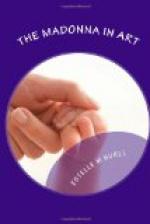[Footnote 3: See particularly Titian’s works in the Louvre, of which the Vierge au Lapin is an especially charming pastoral.]
In Italian art there are two famous pictures of this class: by Francia, in the Munich Gallery, and by Filippino Lippi (or so attributed), in the Pitti, at Florence. In both the motif is the same: in the foreground, a square inclosure surrounded by a rose-hedge, with a hilly landscape in the distance; the Virgin kneeling before her child in the centre. Filippino Lippi’s is one of those pictures whose beauty attracts crowds of admirers to the canvas. Copyists are kept busy, repeating the composition for eager purchasers, and it has made its way all over the world. The circle of graceful angels who, with the boy St. John, join the mother in adoring the Christ-child, is one of the chief attractions of the picture. It is a pretty conceit that one of these angels showers rose leaves upon the babe.
The pastoral Madonna is the sort of picture which can never be outgrown. The charm of nature is as perennial as is the beauty of motherhood, and the two are always in harmony. Here, then, is a proper subject for modern Madonna art, a field which has scarcely been opened by the artists of our own day. Such pastoral Madonnas as have been painted within recent years are all more or less artificial in conception. Compared with the idyllic charm of the sixteenth century pictures, they seem like pretty scenes in a well-mounted opera. We are looking for better things.
CHAPTER V.
THE MADONNA IN A HOME ENVIRONMENT.
A subject so sacred as the Madonna was long held in too great reverence to permit of any common or realistic treatment. The pastoral setting brought the mother and her babe into somewhat closer and more human relations than had before been deemed possible; but art was slow to presume any further upon this familiarity. The Madonna as a domestic subject, represented in the interior of her home, was hesitatingly adopted, and has been so rarely treated, even down to our own times, as to form but a small group of pictures in the great body of art.
[Illustration: SCHONGAUER.—HOLY FAMILY.]
The Northern painters naturally led the way. Peculiarly home-loving in their tastes, their ideal woman is the hausfrau, and it was with them no lowering of the Madonna’s dignity to represent her in this capacity. A picture in the style of Quentin Massys hangs in the Munich Gallery, and shows a Flemish bedroom of the fifteenth century. At the left stands the bed, and on the right burns the fire, with a kettle hanging over it. The Virgin sits alone with her babe at her breast.




